By Jeffrey A. Rendall, Photos By Jeff Janas, ESPN.com and PGATour.com
VALENCIA, CA -- Bob Burns and Rich Beem. At the beginning of the 2002 PGA Tour season, bookmakers wouldn't have found many takers on these guys if they'd offered a line on who would be this year's players to look Tiger Woods in the eye, then beat him head-to-head. Burns had just finished second at PGA Tour Qualifying School (Q-School) at the end of last year, and Beem won the Kemper Open a few years back, yet there was little indication either would rise to prominence in 2002. And these days, beating Tiger Woods when the chips are on the line is considered prominent.
Burns accomplished his feat at the Disney Classic, played last month in Orlando. Woods drew even with Burns on the back nine, and the golfing world braced itself for yet another stirring comeback victory from the young legend, who'd made untold previous final round charges to snatch victory from some unfortunate player who couldn't handle the pressure. Even ABC TV all but conceded Woods' eventual triumph - after all, only Burns stood in Woods' path, and Burns had never won before on the PGA Tour (Tiger's Mom even said as much). How likely would it be that a potential first-time winner could actually be tied with Tiger on the back nine on Sunday, then come out victorious?
For those who know Burns, they're not the least bit surprised. Though his PGA Tour career has lacked a lot of glitter, he's one of many steady performers on the circuit who was due to break through at virtually anytime. It just so happened that the Disney Classic was his time, and it also just so happened that Tiger Woods was the guy to finish behind him (note: Chris DiMarco rallied on the final few holes to finish second. Woods finished third).
Though golf fans now know Bob Burns through his memorable victory, I've known 'of' him since we were in the same high school graduating class in Granada Hills, California (John F. Kennedy High School, Class of '86). I didn't know Burns when we were in school - it was a large high school, and he was the top player on the golf team, and I wasn't... even on the team. Remembering back to those days, he was a skinny kid with a lot of talent for the game (obviously) -- and I played football.
Hindsight may be 20-20, but he made the better choice on which sport to pursue.
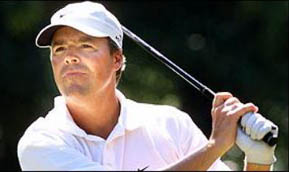 |
After high school, Burns went on to Cal State University Northridge, where he won the NCAA Division II Championship in 1990. He turned pro in 1991, played some on the mini tours, then joined the Ben Hogan Tour (the precursor to the Nike Tour, which then became the Buy.com Tour, which will now be called the Nationwide Tour) in 1992. After a two-year stint on the PGA Tour in '94 and '95, he went back and forth between the Nike Tour and what he calls the 'barbecue circuit,' the Golden State Tour, and participating in various state opens. Rejoining the Nike Tour in '98, he won twice, and has played on the PGA Tour ever since returning for the 1999 season.
At age 34, he hardly qualifies as a journeyman pro, yet the up-and-down nature of his career sheds light on just how difficult it is to stay on any of the professional golf circuits. With his win at the Disney Classic, he's got an automatic two-year exemption on the PGA Tour, which runs through the end of the 2004 season.
Catching up with Burns after his Disney win (and after his near miss at this year's Kemper Open), I asked him about life on the Tour, his practice regimen and some issues facing professional golf these days:
Q: I've followed your career on and off since you turned pro, and I've noticed the couple times you've gone through Q-School, you've done particularly well. Is there something about the format that allowed you to do well there?
Burns: I don't know. I wish I could carry on that play all year-round, then I'd never have to worry about Q-school, you know what I mean? I think I've done well because it's six days and you know you're going to make mistakes at some point, but you just stay focused on the end goal and don't ever get too uptight. I try not to get too uptight about what's immediately going on around me, and keep focusing on the end result no matter whether I've just made a bogey or a double.
Q: Is that the thinking you employed at the Disney?
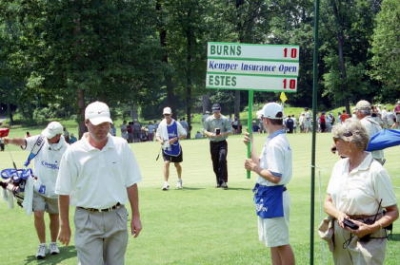 |
| From the 2002 Kemper Open, Burns learned what it was like to be tied for the lead on Sunday. |
Burns: I was hitting the ball so well all week, so even if I had any nerves, it wasn't going to affect how I was hitting it -- that's how I felt, as far as my ball-striking. It was just a matter of getting the job done. I've been in that position before, at every level - college, the mini tours, the Nike tour, and I've been in that position on the PGA Tour (at the Kemper Open, where he played in the final pairing on Sunday), but I haven't closed it out at this level before. Everything was going so well at the Disney, so it was just a matter of letting it happen.
The feeling wasn't really all that different than being in contention on the other tours. It's basically the same job you have to do, just with different people.
Q: As far as handling pressure, I've always thought it must be tough to be on the PGA Tour with the 'fishbowl' mentality. Is it difficult for you to keep a focus when people are walking around and talking and doing all that stuff?
Burns: Actually, the more people, the better, just because the noise turns into kind of a low hum. When there're only a few people out there making noise, or things just happen out of the blue, like someone dropping a beer can, it's a bit of a distraction. You really tend to hear the noises more when there are only a few folks around. But if you've got 50,000 people, the sounds just blend together.
Q: Along those lines, what advice would you give to an amateur player, in terms of handling pressure?
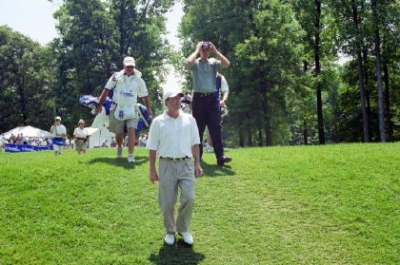 |
| Leaving the 1st tee at TPC Avenel, Burns leads the entourage. |
Burns: Breathe, for one (laughs). Try to breathe, and try to stay calm - and try not to look too far forward. Always keep your next shot as the only one in your mind. That way, you stay focused on a situation you can control.
Q: Now that you've won a tournament, will winning a second time, or contending more often - be easier for you from a mental standpoint?
Burns: I think so. Because now I know how to win. A lot of people have said it's a question of learning how to win out here - and there are an awful lot of talented players out on tour, or really, at every level.
At the Disney, I went in there with the attitude that I was going to win, starting with Wednesday night, before I even woke up for my round on Thursday. Winning was the goal. I'd played so well in Las Vegas the previous week, and barely missed the cut there. I made nineteen birdies (note: Las Vegas' tournament is a five round tournament, with the cut coming after the third round) and 11 bogeys, and missed the cut, but still played well. I knew if I played well at Disney, I wouldn't make all the bogeys, because those courses just aren't set up like the TPC in Vegas.
At the same time, I didn't think my first win would ever come in a tournament where you had to shoot 25-under to win. I'd always envisioned breaking through on a difficult course, where 10 or 12 under was the winning score.
But I liked the Disney courses, the kind of grass surfaces and even the Bermuda greens. It's kind of odd, being from California and really liking Bermuda greens. Everything just suited me well there.
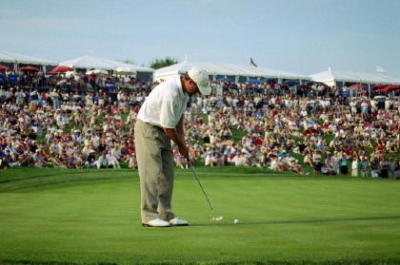 |
| Rolling in his final putt on the 18th green to finish tied for 3rd in the Kemper Open. |
Q: Was there anything you'd been practicing of late that helped you win?
Burns: I've pretty much got a practice routine down, and overall, I think it's shown some results with how I've played this season.
As far as hitting full swing shots, I just work on a couple mechanical things, and try and hit the same shot every time. But the shots that make the difference are the ones I practice on Tuesdays and Wednesdays, around the chipping green.
My caddy will pick out five totally different shots, and I have to keep hitting 'em 'til I make one in each hole. Sometimes it takes a half hour, sometimes it takes 2 1/2 hours (laughs). It really depends on the difficulty of the shot. That way, at least, I'm practicing with the goal of trying to make the shot, and also build it into memory.
My scrambling average has improved over prior years (he ranked 19th on tour in 2002), so it's nice to see all the hard work is paying off. Scrambling is a stat that tells you that your work is being rewarded.
Q: Curtis Strange was talking about the overall depth on the tour, and that's why there've been 18 first-time winners on tour this year. What's it like to play with so many talented players, and not only compete, but beat a good many of them on a consistent basis?
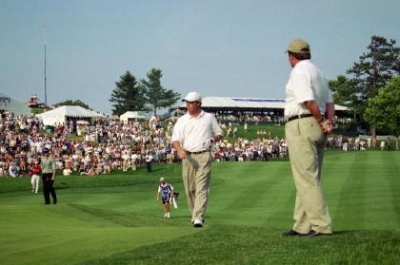 |
| Receiving an ovation from the gallery at the Kemper Open. He'd receive cheers of his own 4 1/2 months later. |
Burns: Playing on tour is what we all work for, all our lives. We're doing what we do for a living, and for our families. It's pretty important to compete, and that's the magnitude of the situation. We're doing it to put food on our table, though that's not as big a motivating factor with the kind of money that's out there these days - you don't have to play as well, and you can still make a pretty good living. But you also have to play to a certain level to be able to keep your tour card.
The cuts have certainly gotten lower in the time I've been on tour, but I don't know if it's any more difficult to make cuts now than it was 10 years ago, despite the infusion of young talent. It's always been possible, if you're on your game, to make cuts. I think I made 19 cuts this year out of 30 events, and that's the most I've ever made.
Q: On the weeks where you might miss a cut, would you say it's because you generally don't play well that week, or because some courses just don't fit your game very well?
Burns: A little bit of both. Some courses don't set up to my eye, and some courses I love and I miss the cut every year, so it doesn't really make a whole lotta sense. But generally, I'd say, the key to making cuts is getting it up and down around the greens. If you're on the edge of playing good or bad, it's a matter of saving the shots. And if you're not saving the shots, you're going to miss the cut.
Q: Getting back to comparing the current situation vs. the 'old days,' what's your take on whether the USGA should try and 'reign in' some of the equipment advances, which are allowing these young guys to hit the ball a mile?
Burns: They've (the USGA) already tried reigning them in, but I think it's too late. If they'd started doing it 15 years ago when a 270 yard drive was still pretty long, it would've made a big difference. Now, a 270 yard drive is barely average.
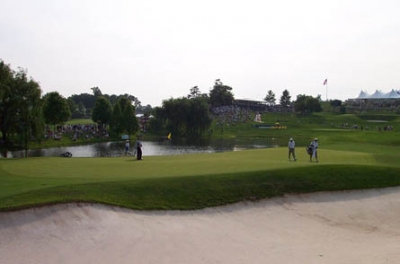 |
| Burns had a nice up and down on the 17th green at Avenel. Every stroke saved means big money at this level. |
You're starting to see the technology really making a difference on the courses, with more players reaching more par fives. I can remember when I first started playing at my home course, Valencia Country Club, in 1988. Back then, I had to play around all the doglegs, and now I can play over 'em. Some of that is development as a player, but a lot of it has to do with the technology of metal woods and balls that go farther.
Q: Do you see the loss of some sponsors for events as being an issue on the Tour?
Burns: I see it as a little bit of an issue. The tour's going to have exposure no matter what, but the sponsors really help the tournaments and the charities. The economy's starting to pick up a bit, and I think it'll really recover in the next couple years, and I don't think sponsorships are going to be a problem.
Q: You've said in the past that playing professional golf is what you 'do,' but that you're not going to play on tour forever. What's life 'after the tour' going to be like?
Burns: I don't know. I'd actually like to play, if possible, a reduced schedule when I'm 40. I'm 34 now, newly married, and we're hoping to have kids soon - and I'd kind of like to be around to coach Little League and help see them through some of their needs. Life on tour can be tough on things like that.
Q: Have any interest in teaching golf?
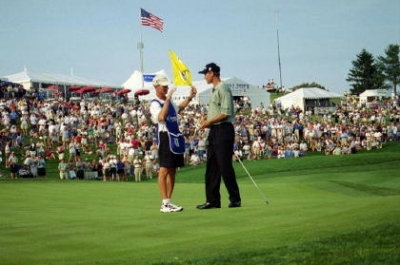 |
| Bob Estes outlasted Burns at the Kemper Open. Burns said Estes' mistake-free final round made the difference. |
Burns: Yes. I've considered, and have been looking into buying a practice range and teaching facility. Not just a driving range, but a good, state-of-the-art teaching facility. I wouldn't mind contributing my time to something like that.
Q: Or maybe brewing some beer?
Burns: Yeah, maybe I'll have my own micro-brew (note: beer brewing was listed as one of his hobbies in the media guide).
Q: Now that the season's over, what's next for you?
Burns: I'm just going to relax. I moved into a new house here in April, and I haven't had a whole lotta time here at home. So we're just going to enjoy it, and get things cleaned up, and get some of the piles sorted out.
Burns said his win at the Disney will get him into next year's PGA Championship, but he'll still need to meet qualifying criteria to get into the other majors. He's played in three US Opens during his career, making the cut in two.
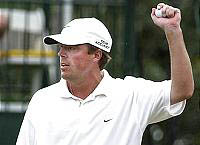 |
| From PGATour.com, we get a glimpse of Burns as he savors victory at the Disney Classic. |
In addition to being a pretty good player, Burns is a nice guy. He'll no longer be anonymous in his journeys on the PGA Tour - winning tends to take that away, especially with winners being paired together in future events. But it doesn't seem like success will change him.
Here's looking forward to seeing a lot more of him in the coming years.
Details:
For more information on Bob Burns or any tour player, I suggest accessing the PGA Tour website, www.PGATOUR.com.
Here's a link for Burns' 2002 stats: Burns' 2002 PGA Tour Statistics
| Related Links | Comments on this article? | |
|
Maryland National Golf Club Hollow Creek Golf Club Rocky Gap Resort PB Dye Golf Club in Ijamsville Whiskey Creek Golf Club |
E-mail Jeff Rendall, Editor: jrendall@golftheunitedstates.com |











